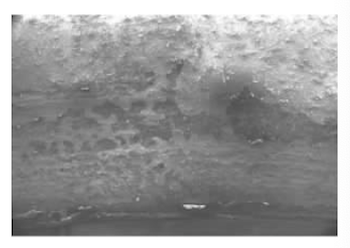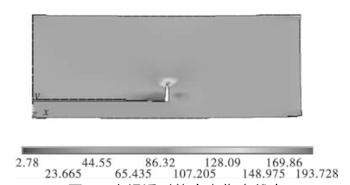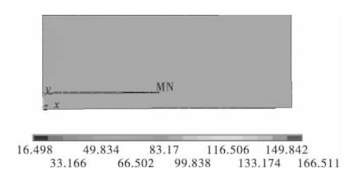Leakages at the Welding Part between Valve Bodies and Socket Welded Flanges
Abstract
The micromorphology of the crack fracture surface and corrosion products and the metallographic structure of the welding seam at the connection between the valve body and the socket welded flange are introduced. The causes of failure such as incomplete welding between the valve body and the socket welded flange and fatigue cracking of the welding seam caused by the valve under vibration were analyzed and solutions were proposed in this article.
1. Overview
The working conditions of the buffer tank at the inlet of the circulating hydrogen compressor are as follows: the operating pressure is 11MPa, temperature 40 to 50°C, medium H2, of which H2S content is 0. 04% to 0. 05%. Use a 1 in. (25.4mm) -900 lb socket welded flange gate valve on a buffer tank level gauge. This valve complies with ASME B31.3 standards. The valve body is made from carbon steel and the wall thickness is less than 20mm. The welding seam of the socket welded flange does not require post-weld heat treatment. After the valve had been in operation for one year, leakage occurred at the welding seam between the valve body and the socket welded flange. In response to this, analysis was conducted from many aspects and effective measures were put forward.
2. Analysis
(1) Material selection of the product
After analyzing the chemical composition, it was determined that the valve is made from low carbon steel. According to the corresponding steel grade standard, the material is No.20 steel, and the material selection is correct. The specific chemical analysis results are shown in Table 1.
Table 1 Chemical composition of socket welding valves %
The micromorphology of the crack fracture surface and corrosion products and the metallographic structure of the welding seam at the connection between the valve body and the socket welded flange are introduced. The causes of failure such as incomplete welding between the valve body and the socket welded flange and fatigue cracking of the welding seam caused by the valve under vibration were analyzed and solutions were proposed in this article.
1. Overview
The working conditions of the buffer tank at the inlet of the circulating hydrogen compressor are as follows: the operating pressure is 11MPa, temperature 40 to 50°C, medium H2, of which H2S content is 0. 04% to 0. 05%. Use a 1 in. (25.4mm) -900 lb socket welded flange gate valve on a buffer tank level gauge. This valve complies with ASME B31.3 standards. The valve body is made from carbon steel and the wall thickness is less than 20mm. The welding seam of the socket welded flange does not require post-weld heat treatment. After the valve had been in operation for one year, leakage occurred at the welding seam between the valve body and the socket welded flange. In response to this, analysis was conducted from many aspects and effective measures were put forward.
2. Analysis
(1) Material selection of the product
After analyzing the chemical composition, it was determined that the valve is made from low carbon steel. According to the corresponding steel grade standard, the material is No.20 steel, and the material selection is correct. The specific chemical analysis results are shown in Table 1.
Table 1 Chemical composition of socket welding valves %
| C | Mn | Si | S | P | Cr | Ni | Cu | |
| Base metal | 0.22 | 0.58 | 0.28 | 0.014 | 0.007 | 0.06 | 0.06 | 0.22 |
| Welding seams | 0.13 | 1.12 | 0.63 | 0.016 | 0.010 | <0.03 | 0.04 | 0.22 |
(2) Macroscopic morphology and metallographic structure
A colored penetrant inspection was performed on the socket welding seam of the valve body and flange near the leakage point, and it was found that there was a crack on the center line of the welding seam, which is also the location where the arc of the welding seam is closed. Taking samples from the cracked welding seam, it can be observed that the welding seam was not welled well, as well as on the heat-affected zone and root (Figure 1). From the crack’s morphology, we can see radial stripes and arc stripes perpendicular to the direction of crack expansion. The fracture surface is smooth, and the fractures fit well. Analysis and research proved that the crack was a fatigue crack propagation; the crack was a fatigue crack, and the crack source was at the root of the welding seam.
Since the welding seam has not undergone post-weld heat treatment, it is also necessary to analyze whether the structure of the welding seam and the base metal has an impact on the occurrence of cracks from the metallographic structure of the material. The boundary between the welding seam and the base metal can be seen in Figure 1. Through metallographic analysis, the structure of the base metal and heat-affected zone is ferrite and pearlite and the structure of the heat-affected zone Widmanstatten structure; the welding seam’s structure is composed of reticular ferrite, pearlite and upper bainite. There are also arc-shaped inclusions in the heat-affected zone (a polished state), but these inclusions should not affect this crack expansion and fracture. The grain size of the base metal is relatively fine, which should be affected by the cooling rate after welding, and post-weld heat treatment not being performed.

Figure 1 Metallographic samples
(3) Microscopic morphology of crack fracture surface and corrosion products
After the crack fracture is opened, its microscopic characteristics are observed under a scanning electron microscope (Figure 2 and Figure 3).

Figure 2 Microscopic morphology of crack fracture surfaces

Figure 3 Microscopic morphology of the crack fracture surface
It can be seen from the microscopic fracture morphology that corrosion products and fatigue striations are attached to the fatigue fracture, and the necessary condition for the generation of fatigue striations is that the crack tip is under an open plane strain condition. According to this, it is determined that the fracture should be a high-stress low-cycle fatigue fracture. At the same time, energy spectrum analysis was conducted on the corrosion product elements present on the fracture surface. The S content was relatively high, which was caused by the medium entering the fracture surface through the crack gap. The contents of other chemical elements are normal. Therefore, the causes of this crack expansion and leakage should also include damage caused by stress corrosion and corrosion fatigue.
(4) Working conditions
The valve is mounted on the level gauge and is in a cantilevered state. Under the action of self-gravity, this part is subject to great tensile stress, and the crack is located in the upper part of the valve’s welding seam. Through finite element simulation calculations, the stress distribution states under good welding and not good welding are shown in Figure 4 and Figure 5. It can be seen from the calculation model that when the socket welding of the valve body and flange is not performed well, the stress is concentrated at the root. At the same time, the valve is located on the buffer tank where the inlet of the circulating hydrogen compressor is subjected to vibration, thus forming fatigue and greater stress. If the welding seam is performed well, the stress level at the root of the welding seam root is low. At the same time, the welding seam has not been heat treated and there is also great residual stress, especially at the arc closing point of the welding seam. The toughness and plasticity of the material decrease, resulting in a decrease in the fatigue limit, and fatigue cracks expand at the arc closing point of the welding seam.

Figure 4 Stress concentration state when the welding is not performed well.

Figure 5 Uniformly distributed stress state during good welding
3. Conclusion
The main reason for the leakage and failure of the socket welding of the valve body and flange is that the socket welding seam is not done well; there is stress concentration, fatigue cracks occur during operation, and the cracks expand under the action of vibration. For similar valves in use, certain measures should be taken to detect the socket welding seams, and replace valves that are not welded well. When selecting a valve connected by flanges, it is recommended to use a butt welding flange structure, and non-destructive testing should be performed after welding to avoid harmful defects in the valve material.
Next: Lap Joint Flanges
Previous: Stainless Steel Flanges
Related News
- Failure and Crack Analysis of an EO/EG Unit Tower Inlet Flange
- Pipe Flange Bolt Tightening in LNG Projects: Key Considerations
- Ultrasonic Testing of High-Neck Flange Welds
- Underwater Flange Connection Methods for Submarine Pipelines
- Key Technologies for Pressure Vessel Testing and Flange Connection Design
- Installation of Main Bolts for Lap Joint Flange in High-Temperature Gas-Cooled Reactors
- Structural Design and Finite Element Analysis of Anchor Flanges
- Key Welding Technology for High-Neck Flange and Steel Pipe Joints
- The Design and Calculation of Stamped Lap Joint Flanges
- Development of Manufacturing Large Anchor Flanges
